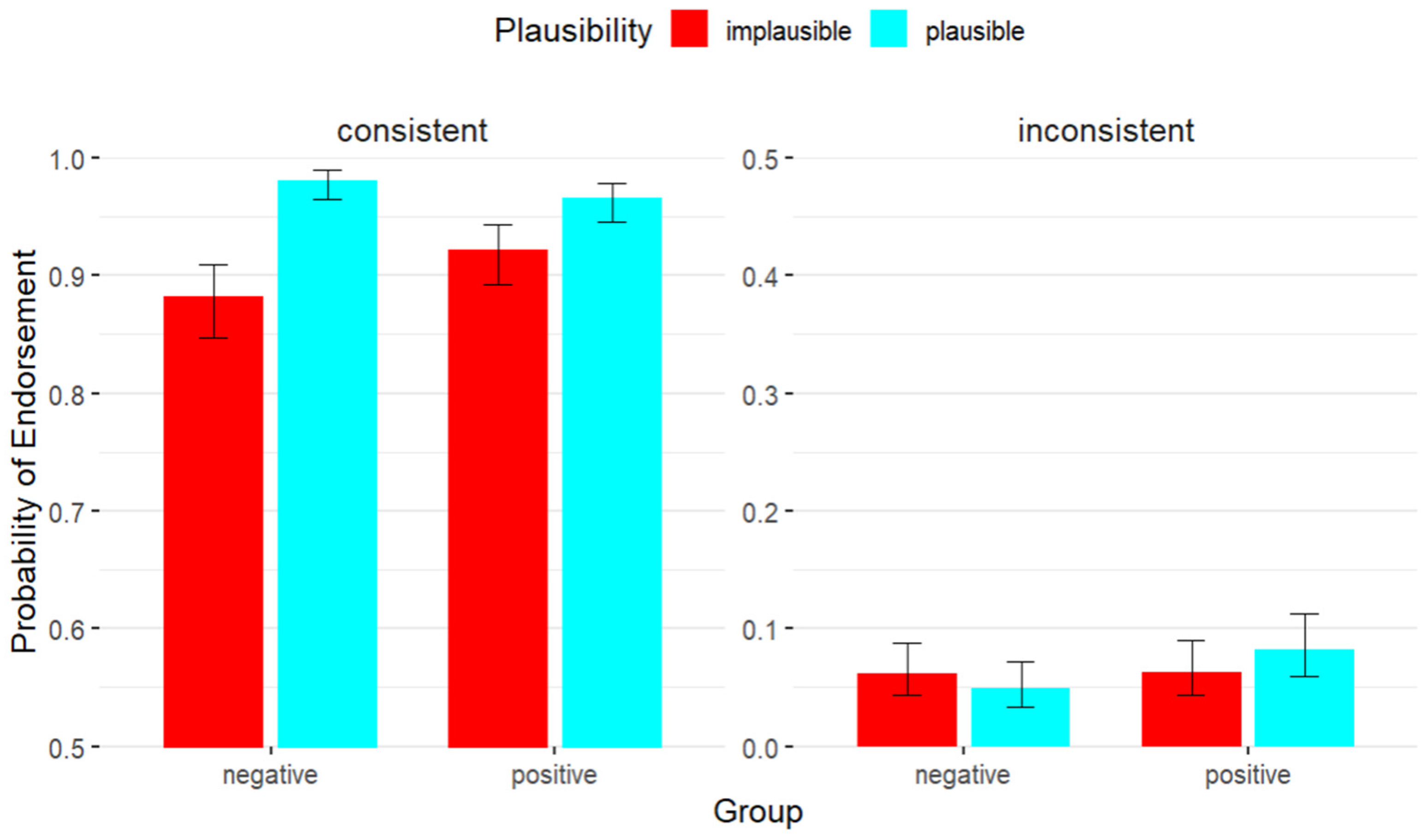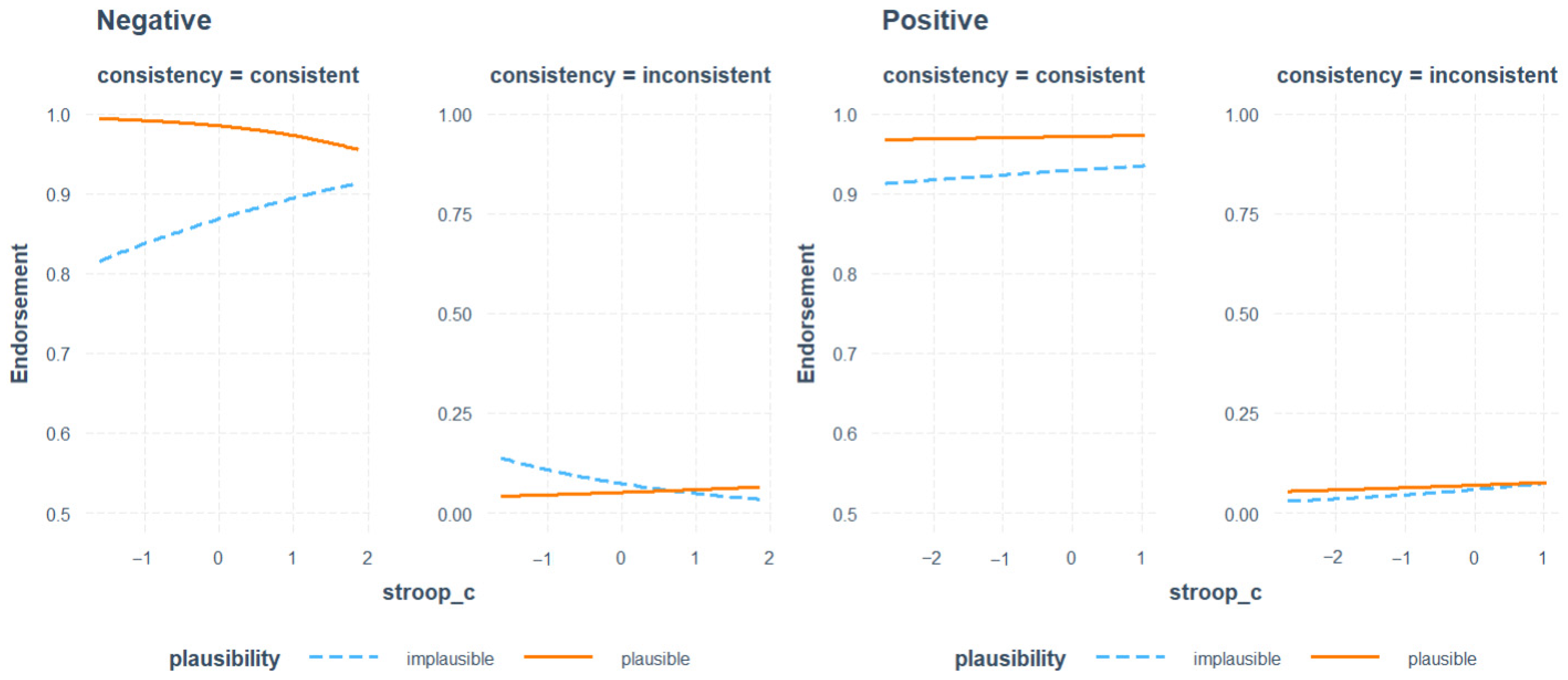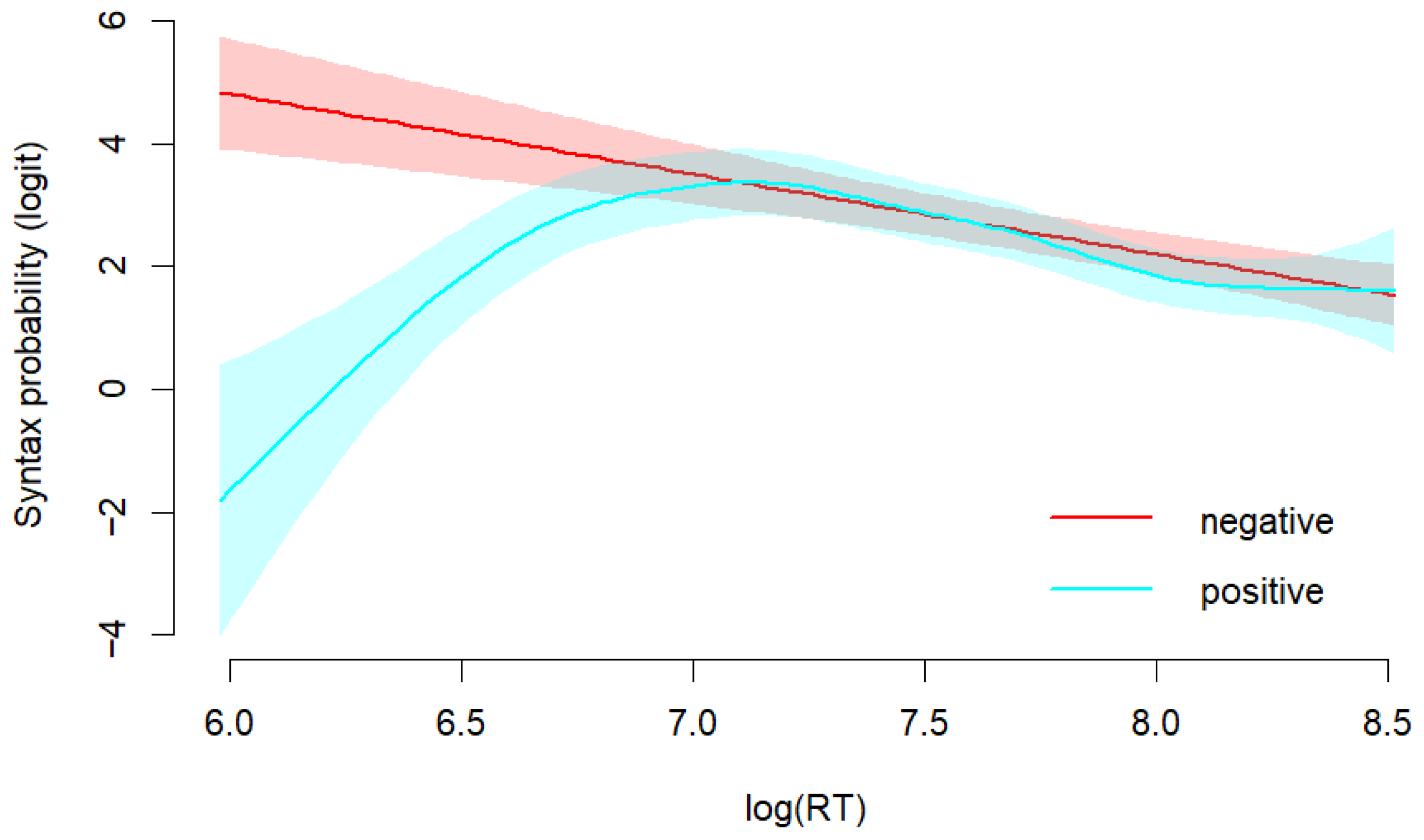Mood Shapes Reliance on Syntactic and Semantic Cues in Sentence Comprehension
Abstract
1. Introduction
2. Materials and Methods
2.1. Participants
2.2. Materials
2.3. Procedures
2.4. Data Analysis
3. Results
3.1. Descriptive Statistics
3.2. Valence Rating Analysis
3.3. Endorsement Analysis
3.3.1. Mood-Related Differences in the Effects of Consistency and Plausibility
3.3.2. The Influence of Inhibitory Control and Working Memory
3.4. Relationship Between RTs and Responses
4. Discussion
Author Contributions
Funding
Institutional Review Board Statement
Informed Consent Statement
Data Availability Statement
Acknowledgments
Conflicts of Interest
References
- Anderson, M. C., & Weaver, C. (2009). Inhibitory control over action and memory. In L. R. Squire (Ed.), Encyclopedia of neuroscience (pp. 153–163). Elsevier. [Google Scholar] [CrossRef]
- Andrews, G., Ogden, J. E., & Halford, G. S. (2017). Resolving conflicts between syntax and plausibility in sentence comprehension. Advances in Cognitive Psychology, 13(1), 11–27. [Google Scholar] [CrossRef]
- Anwyl-Irvine, A. L., Massonnié, J., Flitton, A., Kirkham, N. Z., & Evershed, J. K. (2020). Gorilla in our midst: An online behavioural experiment builder. Behavior Research Methods, 52, 388–407. [Google Scholar] [CrossRef]
- Bates, D., Mächler, M., Bolker, B., & Walker, S. (2015). Fitting linear mixed-effects models using lme4. Journal of Statistical Software, 67, 1–48. [Google Scholar] [CrossRef]
- Beukeboom, C. J., & Semin, G. R. (2002, January 31). The influence of mood states on cognitive processing and language use: How mood turns on language. Poster Session Presented at SPSP Conference, Savannah, GA, USA. [Google Scholar]
- Beukeboom, C. J., & Semin, G. R. (2006). How mood turns on language. Journal of Experimental Social Psychology, 42(5), 553–566. [Google Scholar] [CrossRef]
- Bless, H., Mackie, D. M., & Schwarz, N. (1992). Mood effects on attitude judgments: Independent effects of mood before and after message elaboration. Journal of Personality and Social Psychology, 63(4), 585–595. [Google Scholar] [CrossRef] [PubMed]
- Bornkessel, I., Zysset, S., Friederici, A. D., Von Cramon, D. Y., & Schlesewsky, M. (2005). Who did what to whom? The neural basis of argument hierarchies during language comprehension. Neuroimage, 26(1), 221–233. [Google Scholar] [CrossRef]
- Bradley, M. M., & Lang, P. J. (1994). Measuring emotion: The self-assessment manikin and the semantic differential. Journal of Behavior Therapy and Experimental Psychiatry, 25(1), 49–59. [Google Scholar] [CrossRef]
- Christianson, K., Williams, C. C., Zacks, R. T., & Ferreira, F. (2006). Younger and older adults’“ good-enough” interpretations of garden-path sentences. Discourse Processes, 42(2), 205–238. [Google Scholar] [CrossRef]
- Chwilla, D. J. (2022). Context effects in language comprehension: The role of emotional state and attention on semantic and syntactic processing. Frontiers in Human Neuroscience, 16, 1014547. [Google Scholar] [CrossRef]
- Chwilla, D. J., Virgillito, D., & Vissers, C. T. W. (2011). The relationship of language and emotion: N400 support for an embodied view of language comprehension. Journal of Cognitive Neuroscience, 23(9), 2400–2414. [Google Scholar] [CrossRef] [PubMed]
- Cutting, L. E., Materek, A., Cole, C. A. S., Levine, T. M., & Mahone, E. M. (2009). Effects of fluency, oral language, and executive function on reading comprehension performance. Annals of Dyslexia, 59(1), 34–54. [Google Scholar] [CrossRef] [PubMed]
- Daneman, M., & Carpenter, P. A. (1980). Individual differences in working memory and reading. Journal of Verbal Learning & Verbal Behavior, 19(4), 450–466. [Google Scholar] [CrossRef]
- Diamond, A. (2013). Executive functions. Annual Review of Psychology, 64(1), 135–168. [Google Scholar] [CrossRef]
- Easterbrook, J. A. (1959). The effect of emotion on cue utilization and the organization of behavior. Psychological Review, 66(3), 183–201. [Google Scholar] [CrossRef]
- Federmeier, K. D., Kirson, D. A., Moreno, E. M., & Kutas, M. (2001). Effects of transient, mild mood states on semantic memory organization and use: An event-related potential investigation in humans. Neuroscience Letters, 305(3), 149–152. [Google Scholar] [CrossRef] [PubMed]
- Ferreira, F. (2003). The misinterpretation of noncanonical sentences. Cognitive Psychology, 47(2), 164–203. [Google Scholar] [CrossRef]
- Ferreira, F., Bailey, K. G. D., & Ferraro, V. (2002). Good-enough representations in language comprehension. Current Directions in Psychological Science, 11(1), 11–15. [Google Scholar] [CrossRef]
- Ferreira, F., & Patson, N. D. (2007). The ‘good enough’ approach to language comprehension. Language and Linguistics Compass, 1(1–2), 71–83. [Google Scholar] [CrossRef]
- Finucane, A. M. (2011). The effect of fear and anger on selective attention. Emotion, 11(4), 970–974. [Google Scholar] [CrossRef]
- Forster, K. I., & Olbrei, I. (1973). Semantic heuristics and syntactic analysis. Cognition, 2(3), 319–347. [Google Scholar] [CrossRef]
- Fredrickson, B. L. (1998). What good are positive emotions? Review of General Psychology, 2(3), 300–319. [Google Scholar]
- Fredrickson, B. L. (2001). The role of positive emotions in positive psychology: The broaden-and-build theory of positive emotions. American Psychologist, 56(3), 218–226. [Google Scholar] [CrossRef] [PubMed]
- Fredrickson, B. L., & Branigan, C. (2005). Positive emotions broaden the scope of attention and thought-action repertoires. Cognition and Emotion, 19(3), 313–332. [Google Scholar] [CrossRef]
- Fujita, H., & Cunnings, I. (2020). Reanalysis and lingering misinterpretation of linguistic dependencies in native and non-native sentence comprehension. Journal of Memory and Language, 115, 104154. [Google Scholar]
- Gasper, K., & Clore, G. L. (2002). Attending to the big picture: Mood and global versus local processing of visual information. Psychological Science, 13(1), 34–40. [Google Scholar]
- Ge, Y., Zhao, G., Zhang, Y., Houston, R. J., & Song, J. (2019). A standardised database of Chinese emotional film clips. Cognition and Emotion, 33(5), 976–990. [Google Scholar]
- Hasher, L., & Zacks, R. T. (1988). Working memory, comprehension, and aging: A review and a new view. Psychology of Learning and Motivation, 22, 193–225. [Google Scholar]
- Hsieh, S., & Lin, S. J. (2019). The dissociable effects of induced positive and negative moods on cognitive flexibility. Scientific Reports, 9, 2919. [Google Scholar] [CrossRef]
- Hwang, K., Ghuman, A. S., Manoach, D. S., Jones, S. R., Luna, B., & Hämäläinen, M. S. (2014). Cortical neurodynamics of inhibitory control. The Journal of Neuroscience, 34(29), 9551–9561. [Google Scholar] [CrossRef]
- Isen, A. M. (2000). Positive affect and decision making. In M. Lewis, & J. M. Haviland-Jones (Eds.), Handbook of emotions (2nd ed., pp. 417–435). Guilford Press. [Google Scholar]
- Just, M. A., & Carpenter, P. A. (1992). A capacity theory of comprehension: Individual differences in working memory. Psychological Review, 99(1), 122–149. [Google Scholar] [PubMed]
- Katzir, M., Eyal, T., Meiran, N., & Kessler, Y. (2010). Imagined positive emotions and inhibitory control: The differentiated effect of pride versus happiness. Journal of Experimental Psychology: Learning, Memory, and Cognition, 36(5), 1314–1320. [Google Scholar] [CrossRef]
- Kim, A., & Osterhout, L. (2005). The independence of combinatory semantic processing: Evidence from event-related potentials. Journal of Memory and Language, 52(2), 205–225. [Google Scholar] [CrossRef]
- Kim, A., & Sikos, L. (2011). Conflict and surrender during sentence processing: An ERP study of syntax-semantics interaction. Brain and Language, 118(1–2), 15–22. [Google Scholar] [CrossRef] [PubMed]
- Kos, M., Vosse, T., Van Den Brink, D., & Hagoort, P. (2010). About edible restaurants: Conflicts between syntax and semantics as revealed by ERPs. Frontiers in Psychology, 1, 222. [Google Scholar] [CrossRef]
- Kuznetsova, A., Brockhoff, P. B., & Christensen, R. H. (2017). lmerTest package: Tests in linear mixed effects models. Journal of Statistical Software, 82, 1–26. [Google Scholar] [CrossRef]
- Leckey, M., & Federmeier, K. D. (2020). The P3b and P600(s): Positive contributions to language comprehension. Psychophysiology, 57(7), e13351. [Google Scholar] [CrossRef] [PubMed]
- Lenth, R. V. (2025). emmeans: Estimated marginal means, aka least-squares means (R package version 1.10.7) [R package]. CRAN. Available online: https://cran.r-project.org/package=emmeans (accessed on 10 March 2025).
- Liu, X. (2024). Age differences in the recruitment of syntactic analysis and semantic plausibility during sentence comprehension. The Journal of General Psychology, 151(4), 444–466. [Google Scholar] [CrossRef]
- Miyake, A., Friedman, N. P., Emerson, M. J., Witzki, A. H., Howerter, A., & Wager, T. D. (2000). The unity and diversity of executive functions and their contributions to complex “frontal lobe” tasks: A latent variable analysis. Cognitive Psychology, 41(1), 49–100. [Google Scholar] [CrossRef] [PubMed]
- Nadler, R. T., Rabi, R., & Minda, J. P. (2010). Better mood and better performance: Learning rule-described categories is enhanced by positive mood. Psychological Science, 21(12), 1770–1776. [Google Scholar] [CrossRef]
- Obler, L. K., Fein, D., Nicholas, M., & Albert, M. L. (1991). Auditory comprehension and aging: Decline in syntactic processing. Applied Psycholinguistics, 12(4), 433–452. [Google Scholar] [CrossRef]
- Qian, Z., Garnsey, S., & Christianson, K. (2018). A comparison of online and offline measures of good-enough processing in garden-path sentences. Language, Cognition and Neuroscience, 33(2), 227–254. [Google Scholar] [CrossRef]
- R Core Team. (2021). R: A language and environment for statistical computing. R Foundation for Statistical Computing. Available online: https://www.R-project.org/ (accessed on 20 February 2025).
- Schwarz, N. (1990). Feelings as information: Informational and motivational functions of affective states. In E. T. Higgins, & R. Sorrentino (Eds.), Handbook of motivation and cognition: Vol. 2 (pp. 527–561). Guilford. [Google Scholar]
- Schwarz, N. (2001). Feelings as information: Implications for affective influences on information processing. In L. L. Martin, & G. L. Clore (Eds.), Theories of mood and cognition: A user’s guidebook (pp. 159–176). Lawrence Erlbaum Associates Publishers. [Google Scholar]
- Schwarz, N. (2002). Situated cognition and the wisdom of feelings: Cognitive tuning. In L. Feldman Barrett, & P. Salovey (Eds.), The wisdom in feelings (pp. 144–166). Guilford Press. [Google Scholar]
- Schwarz, N., Bless, H., & Bohner, G. (1991). Mood and persuasion: Affective states influence the processing of persuasive communications. Advances in Experimental Social Psychology, 24, 161–199. [Google Scholar]
- Sesma, H. W., Mahone, E. M., Levine, T., Eason, S. H., & Cutting, L. E. (2009). The contribution of executive skills to reading comprehension. Child Neuropsychology, 15(3), 232–246. [Google Scholar] [CrossRef]
- Slattery, T. J., Sturt, P., Christianson, K., Yoshida, M., & Ferreira, F. (2013). Lingering misinterpretations of garden path sentences arise from competing syntactic representations. Journal of Memory and Language, 69(2), 104–120. [Google Scholar] [CrossRef]
- Stella, M., & Engelhardt, P. E. (2022). Use of parsing heuristics in the comprehension of passive sentences: Evidence from dyslexia and individual differences. Brain Sciences, 12(2), 209. [Google Scholar] [CrossRef] [PubMed]
- Storbeck, J., & Clore, G. L. (2008). Affective arousal as information: How affective arousal influences judgments, learning, and memory. Social and Personality Psychology Compass, 2(5), 1824–1843. [Google Scholar] [CrossRef]
- Stroop, J. R. (1935). Studies of interference in serial verbal reactions. Journal of Experimental Psychology, 18(6), 643–662. [Google Scholar] [CrossRef]
- Swets, B., Desmet, T., Hambrick, D. Z., & Ferreira, F. (2007). The role of working memory in syntactic ambiguity resolution: A psychometric approach. Journal of Experimental Psychology: General, 136(1), 64–81. [Google Scholar] [CrossRef] [PubMed]
- Van Berkum, J. J. A., Holleman, B., Nieuwland, M., Otten, M., & Murre, J. (2013). Right or wrong? The brain’s fast response to morally objectionable statements. Psychological Science, 20(9), 1092–1099. [Google Scholar] [CrossRef]
- Verhees, M. W., Chwilla, D. J., Tromp, J., & Vissers, C. T. (2015). Contributions of emotional state and attention to the processing of syntactic agreement errors: Evidence from P600. Frontiers in Psychology, 6, 388. [Google Scholar] [CrossRef]
- Vissers, C. T. W. M., Chwilla, U. G., Egger, J. I. M., & Chwilla, D. J. (2013). The interplay between mood and language comprehension: Evidence from P600 to semantic reversal anomalies. Neuropsychologia, 51, 1027–1039. [Google Scholar] [CrossRef]
- Vissers, C. T. W. M., Virgillito, D., Fitzgerald, D. A., Speckens, A. E., Tendolkar, I., van Oostrom, I., & Chwilla, D. J. (2010). The influence of mood on the processing of syntactic anomalies: Evidence from P600. Neuropsychologia, 48(12), 3521–3531. [Google Scholar] [CrossRef]
- Wang, Y., Chen, J., & Yue, Z. (2017). Positive emotion facilitates cognitive flexibility: An fMRI study. Frontiers in Psychology, 8, 1832. [Google Scholar] [CrossRef]
- Wiecki, T. V., & Frank, M. J. (2013). A computational model of inhibitory control in frontal cortex and basal ganglia. Psychological Review, 120(2), 329–355. [Google Scholar] [CrossRef] [PubMed]
- Wood, S. (2025). mgcv: Mixed GAM computation vehicle with automatic smoothness estimation (Version 1.9-3) [R package]. Comprehensive R Archive Network (CRAN). Available online: https://cran.r-project.org/package=mgcv (accessed on 11 June 2025).
- Yang, H., & Yang, S. (2014). Positive affect facilitates task switching in the dimensional change card sort task: Implications for the shifting aspect of executive function. Cognition and Emotion, 28(7), 1242–1254. [Google Scholar] [CrossRef] [PubMed]
- Ye, Z., & Zhou, X. (2009). Conflict control during sentence comprehension: fMRI evidence. NeuroImage, 48(1), 280–290. [Google Scholar] [CrossRef] [PubMed]





| Positive | Negative | |
|---|---|---|
| Age | 23.1/1.70 (21−28) | 23.1/2.36 (19−31) |
| Education (years) | 17.2/1.64 | 16.9/2.51 |
| Gender (Male %) | 38.9% | 42.1% |
| Condition | Sentence | Probe |
|---|---|---|
| CP | a. nage xunlian qiuyuan de jiaolian jianchale qicai | The coach trained the athletes. |
| b. the trained athletes DE coach checked equipment | ||
| c. The coach who trained the athletes checked the equipment. | ||
| CImp | a. nage xunlian jiaolian de qiuyuan jianchale qicai | The athletes trained the coach. |
| b. the trained coach DE athletes checked equipment | ||
| c. The athletes who trained the coach checked the equipment. | ||
| IncP | a. nage xunlian jiaolian de qiuyuan jianchale qicai | The coach trained the athletes. |
| b. the trained coach DE athletes checked equipment | ||
| c. The athletes who trained the coach checked the equipment. | ||
| IncImp | a. nage xunlian qiuyuan de jiaolian jianchale qicai | The athletes trained the coach. |
| b. the trained athletes DE coach checked equipment | ||
| c. The coach who trained the athletes checked the equipment. |
| Group | Consistency | Plausibility | Accuracy (M/SD) | RT (M/SD) |
|---|---|---|---|---|
| Negative | Consistent | Plausible | 0.981 (0.136) | 1.590 (0.758) |
| Negative | Consistent | Implausible | 0.908 (0.289) | 1.878 (0.864) |
| Negative | Inconsistent | Plausible | 0.947 (0.224) | 1.906 (0.875) |
| Negative | Inconsistent | Implausible | 0.945 (0.227) | 1.935 (0.909) |
| Positive | Consistent | Plausible | 0.964 (0.186) | 1.576 (0.764) |
| Positive | Consistent | Implausible | 0.915 (0.280) | 1.795 (0.832) |
| Positive | Inconsistent | Plausible | 0.911 (0.285) | 1.872 (0.864) |
| Positive | Inconsistent | Implausible | 0.937 (0.244) | 1.782 (0.801) |
Disclaimer/Publisher’s Note: The statements, opinions and data contained in all publications are solely those of the individual author(s) and contributor(s) and not of MDPI and/or the editor(s). MDPI and/or the editor(s) disclaim responsibility for any injury to people or property resulting from any ideas, methods, instructions or products referred to in the content. |
© 2025 by the authors. Licensee MDPI, Basel, Switzerland. This article is an open access article distributed under the terms and conditions of the Creative Commons Attribution (CC BY) license (https://creativecommons.org/licenses/by/4.0/).
Share and Cite
Liu, X.; Wu, S.; Wang, X. Mood Shapes Reliance on Syntactic and Semantic Cues in Sentence Comprehension. Behav. Sci. 2025, 15, 1591. https://doi.org/10.3390/bs15111591
Liu X, Wu S, Wang X. Mood Shapes Reliance on Syntactic and Semantic Cues in Sentence Comprehension. Behavioral Sciences. 2025; 15(11):1591. https://doi.org/10.3390/bs15111591
Chicago/Turabian StyleLiu, Xinmiao, Shengqi Wu, and Xiaoli Wang. 2025. "Mood Shapes Reliance on Syntactic and Semantic Cues in Sentence Comprehension" Behavioral Sciences 15, no. 11: 1591. https://doi.org/10.3390/bs15111591
APA StyleLiu, X., Wu, S., & Wang, X. (2025). Mood Shapes Reliance on Syntactic and Semantic Cues in Sentence Comprehension. Behavioral Sciences, 15(11), 1591. https://doi.org/10.3390/bs15111591





